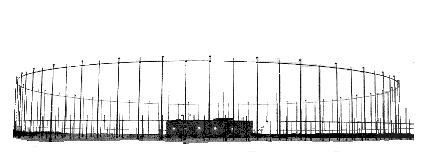




HF-DF stations detect radio signals from aircraft or ships, and calculate the direction, or line of bearing, of the radio transmitter from the direction finding antenna. When the same signal is received by two or more antennae, the intersection of the lines of bearing marks the transmitter's location, using either precision single station location (SSL) capability, or in a network of DF stations using both multi-station azimuth triangulation and SSL. High Frequency Acquisition (AQ) and Direction Finding (DF) operations are performed with the Narrowband System (NBS) and Wideband Direction Finding (WBDF) Subsystem in support of normal and degraded communications modes, using both adaptive reception and super-resolution direction finding techniques.
CLASSIC BULLSEYE stations consist of the AN/FRD-10 circularly disposed antenna arrays (CDAA), popularly known as elephant cages. With a nominal range between 150 to 5000 kilometers, these arrays consist of two rings of HF antennae. The inner ring, for monitoring shorter wavelength signals, is typically some 230 meters in diameter with some 40 folded dipoles. The outer ring for monitoring longer HF wavelengths is about 260 meters in diameter and contains some 120 sleeve monopoles. Inside each ring is a large wire screen, supported by 80 towers, to shield antennae on the other side of the array from HF signals from crossing the array, which would interfere with geolocation operations. A horizontal ground screen about 400 meters in diameter surrounds the entire site. The station's intercept operators work in an operations building in the center of the array.